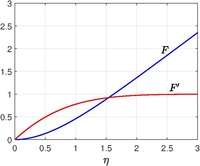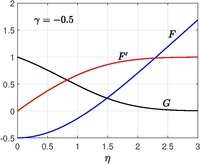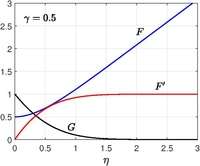Stagnation point flow
In fluid dynamics, Stagnation point flow represents a fluid flow in the immediate neighborhood of solid surface at which fluid approaching the surface divides into different streams or a counterflowing fluid streams encountered in experiments. Although the fluid is stagnant everywhere on the solid surface due to no-slip condition, the name stagnation point refers to the stagnation points of inviscid Euler solutions.
Hiemenz flow[1][2]

Hiemenz[3] formulated the problem and calculated the solution numerically in 1911 and subsequently by Leslie Howarth(1934).[4] The flow in the neighborhood of the stagnation point can be modeled by a flow towards an infinite flat plate, even though the whole body is a curved one(locally curvature effects are negligible). Let the plate be in the plane with representing the stagnation point. The inviscid stream function and velocity from Potential flow theory are
where is an arbitrary constant (represents strain rate in the counter flow setup). For real fluid(including viscous effects), there exists a self-similar solution if one defines
where is the Kinematic viscosity and is a boundary layer thickness but it is constant(vorticity generated at the solid surface is prevented diffusing far away by an opposing convection, similar profiles are Blasius boundary layer with suction, Von Kármán swirling flow etc.,). Then the velocity components and subsequently pressure and the equation for using Navier–Stokes equations are
and the boundary condition due to no penetration and no-slip and the free stream condition for (Note boundary conditions for far away from the plate is not specified, because it is part of the solution - a typical boundary layer problem) are
The problem formulated here is the special case of Falkner-Skan boundary layer. The asymptotic forms for large are
where is the displacement thickness.
Stagnation point flow with translating plate[5]
Stagnation point flow with moving plate with constant velocity can be considered as model for rotating solids near the stagnation points. The stream function is
where satisfies the equation
and Rott(1956)[6] gave the solution as
Oblique stagnation point flow
The previous analyses assumes the flow impinges in normal direction. The inviscid stream function for oblique stagnation point flow is obtained by adding a constant vorticity .
The corresponding analysis for viscous fluid is studied by Stuart(1959),[7] Tamada(1979)[8] and Dorrepaal(1986).[9] The self-similar stream function is,
where satisfies the equation
- .
Homann flow


The corresponding problem in axisymmetric coordinate is solved by Homann(1936)[10] and this serves a model for flow around near the stagnation point of a sphere. Paul A. Libby(1974)[11](1976)[12] considered Homann flow with constantly moving plate with velocity and also allowed for suction/injection with velocity at the surface.
The self-similar solution is obtained by introducing following transformation for the velocity in cylindrical coordinates
and the pressure is given by
Therefore, the Navier–Stokes equations reduce to
with boundary conditions,
When , the classical Homann problem is recovered.
Plane counterflows
Jets emerging from a slot-jets creates stagnation point in between according to potential theory. The flow near the stagnation point can by studied using self-similar solution. This setup is widely used in combustion experiments. The initial study of impinging stagnation flows are due to C.Y. Wang.[13][14] Let two fluids with constant properties denoted with suffix flowing from opposite direction impinge and let's assume the two fluids are immiscible and the interface(located at ) is planar. The velocity is given by
where are strain rates of the fluids. At the interface, velocities, tangential stress and pressure must be continuous. Introducing the self-similar transformation,
results equations,
The no-penetration condition at the interface and free stream condition far away from the stagnation plane become
But the equations require two more boundary conditions. At , the tangential velocities , the tangential stress and the pressure are continuous. Therefore,
where (from outer inviscid problem) is used. Both are not known apriori, but derived from matching conditions. The third equation is determine variation of outer pressure due to the effect of viscosity. So there are only two parameters, which governs the flow, which are
then the boundary conditions become
- .
Constant density and constant viscosity
When densities and viscosities of the two impinging jets are same and constant, then the strain rate is also constant and the potential flow solution become the solution of the Navier-Stokes equations, i.e.,
everywhere in the flow domain. Kerr and Dold found additional new solution called as Kerr–Dold vortex of Navier-Stokes equations in 1994 in the form of periodic array of steady vortices superposed on the constant density and constant viscosity counterflowing jets.[15]
References
- Rosenhead, Louis, ed. Laminar boundary layers. Clarendon Press, 1963.
- Batchelor, George Keith. An introduction to fluid dynamics. Cambridge University Press, 2000.
- Hiemenz, Karl. Die Grenzschicht an einem in den gleichförmigen Flüssigkeitsstrom eingetauchten geraden Kreiszylinder... Diss. 1911.
- Howarth, Leslie. On the calculation of steady flow in the boundary layer near the surface of a cylinder in a stream. No. ARC-R/M-1632. AERONAUTICAL RESEARCH COUNCIL LONDON (UNITED KINGDOM), 1934.
- Drazin, Philip G., and Norman Riley. The Navier–Stokes equations: a classification of flows and exact solutions. No. 334. Cambridge University Press, 2006.
- Rott, Nicholas. "Unsteady viscous flow in the vicinity of a stagnation point." Quarterly of Applied Mathematics 13.4 (1956): 444–451.
- Stuart, J. T. "The viscous flow near a stagnation point when the external flow has uniform vorticity." Journal of the Aerospace Sciences (2012).
- Tamada, Ko. "Two-dimensional stagnation-point flow impinging obliquely on a plane wall." Journal of the Physical Society of Japan 46 (1979): 310.
- Dorrepaal, J. M. "An exact solution of the Navier–Stokes equation which describes non-orthogonal stagnation-point flow in two dimensions." Journal of Fluid Mechanics 163 (1986): 141–147.
- Homann, Fritz. "Der Einfluss grosser Zähigkeit bei der Strömung um den Zylinder und um die Kugel." ZAMM‐Journal of Applied Mathematics and Mechanics/Zeitschrift für Angewandte Mathematik und Mechanik 16.3 (1936): 153–164.
- Libby, Paul A. "Wall shear at a three-dimensional stagnation point with a moving wall." AIAA Journal 12.3 (1974): 408–409.
- Libby, Paul A. "Laminar flow at a three-dimensional stagnation point with large rates of injection." AIAA Journal 14.9 (1976): 1273–1279.
- Wang, C. Y. "Stagnation flow on the surface of a quiescent fluid—an exact solution of the Navier–Stokes equations." Quarterly of applied mathematics 43.2 (1985): 215–223.
- Wang, C. Y. "Impinging stagnation flows." The Physics of fluids 30.3 (1987): 915–917.
- Kerr, O. S., & Dold, J. W. (1994). Periodic steady vortices in a stagnation-point flow. Journal of Fluid Mechanics, 276, 307-325.